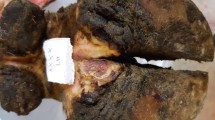Abstract
Pythium insidiosum is a fungus-like organism present in subtropical and tropical areas, such as Brazil, known to infect humans and various animal species. P. insidiosum is the etiological agent of pythiosis, an emerging and granulomatous disease characterized mainly by cutaneous and subcutaneous lesions in horses, the principal species affected. Accurate diagnosis of pythiosis and identification of its causal agent by microbiological and serological tests can be often difficult and inconclusive principally for horses and humans. The aim of this study was to evaluate the application of the previously described P. insidiosum-specific nested polymerase chain reaction (PCR) assay to directly detect P. insidiosum DNA in clinical and experimental lesions. Universal fungal primers (ITS1 and ITS4) were used during the first-round of PCR to amplify ITS1, 5.8s, and ITS2. A second-round of PCR was conducted with P. insidiosum-specific primers (PI1 and PI2) to amplify a variable region within this ITS1. In this study, a total of 21 equine clinical samples (kunkers) and 28 specimens from experimentally infected rabbits were analyzed by nested PCR. The first-round of PCR generated 800-base pair products, and the second-round produced 105-base pair amplicons for each P. insidiosum-specific sample; no amplicons were generated in negative control samples. Our results suggest that nested PCR is an important and efficient tool for diagnosis of both endemic (horse samples) and experimental (rabbit samples) pythiosis.


Similar content being viewed by others
References
Alexopoulos CJ, Mims CW, Blackwell M (1996). Fungal systematics. In: Introductory mycology. Wiley, New York, pp 683–737
Bosco SMG, Reis GM, Theodoro RC et al (2008) Morphological and molecular characterization o fan equine isolate of Pythium insidiosum and comparison with the first human isolate from the same geographic region. Med Mycol 46:557–565
Groff ACM (2005) PCR para o diagnóstico da campilobacteriose genital bovina. Dissertação apresentada ao Curso de Mestrado do Programa de Pós-graduação em Medicina Veterinária, Área de concentração Medicina Veterinária Preventiva, Universidade Federal de Santa Maria (UFSM, RS), Santa Maria, RS, 39 pp (thesis in Portuguese)
Grooters AM, Gee MK (2002) Development of a nested polymerase chain reaction assay for the detection and identification of Pythium insidiosum. J Vet Intern Med 16:147–152
Mendoza L, Kaufman L, Standard PG (1986) Immunodiffusion test for diagnosing and monitoring pythiosis in horses. J Clin Microbiol 23:813–816
Mendoza L, Kaufman L, Standard PG (1987) Antigenic relationship between the animal and human pathogen Pythium insidiosum and nonpathogenic Pythium species. J Clin Microbiol 25:2159–2162
Mendoza L, Nicholson V, Prescott JF (1992) Immunoblot analysis of the humoral immune response to Pythium insidiosum in horses with pythiosis. J Clin Microbiol 30:2980–2983
Mendoza L, Kaufmann L, Mandy W et al (1997) Serodiagnosis of human and animal pythiosis using an enzyme-linked immunosorbent assay. Clin Diagn Lab Immunol 4:715–718
Miller RI, Campbell RSF (1982) Immunological studies on equine phycomycosis. Aust Vet J 58:227–231
Miller RI, Campbell RSF (1983) Experimental pythiosis in rabbits. Sabouraudia 21:331–341
Murray P, Baron EJ, Pfaller MA et al (1995) Manual of clinical microbiology. ASM Press, Washington, p 1482
Pereira DIB (2008) Suscetibilidade in vitro e in vivo de Pythium insidiosum: estudo comparativo entre acetato de caspofungina e imunoterapia em coelhos. Tese de Doutorado n. 86 (Especialidade: Micologia). Programa de Pós-Graduação em Ciências Veterinárias. www.ufrgs.br/ppgcv. Faculdade de Veterinária, Universidade Federal do Rio Grande do Sul (UFRGS), Porto Alegre, RS, 117 pp (thesis in Portuguese)
Pesavento PA, Barr B, Riggs SM et al (2008) Cutaneous pythiosis in a nestling white-faced ibis. Vet Pathol 45:538–541
Santurio JM, Ferreiro L (2008) Pitiose: Uma Abordagem Micológica e Terapêutica. Porto Alegre, Ed. da Universidade Federal do Rio Grande do Sul, 111 pp
Santurio JM, Leal AT, Leal AB et al (2003) Three types of immunotherapics against pythiosis insidiosi developed and evaluated. Vaccine 21:2535–2540
Schurcho AM, Mendoza L, de Cock AWAM et al (2004) Development of a species-specific probe for Pythium insidiosum and the diagnosis of pythiosis. J Clin Microbiol 42:2411–2418
Schurko AM, Mendoza L, de Cock AWAM et al (2003) Evidence for geographic clusters: molecular genetic differences among strains of Pythium insidiosum from Asia, Australia, and the Americas are explored. Mycologia 95:200–208
Supabandhu J, Fisher MC, Mendoza et al (2007) Isolation and identification of the human pathogen Pythium insidiosum from environmental samples collected in Thai agricultural areas. Med Mycol 46:41–52
Villa NO, Kageyama K, Asano T et al (2006) Phylogenetic relationships of Pythium and Phytophthora species based on ITS rDNA, cytochrome oxidase II and β-tubulin gene sequences. Mycologia 98:410–422
Wang PH, White JG (1997) Molecular characterization of Pythium species based on RFLP analysis of the internal transcribed spacer region of ribosomal DNA. Physiol Mol Plant Pathol 51:129–143
White TJ, Burns T, Lee S et al (1990) Amplification and direct sequencing of fungal ribosomal RNA genes for phylogenetics. In: Innis MA, Gelfand DH, Sninsky JJ, White TJ (eds) PCR protocols: a guide to methods and applications. Academic Press, San Diego, pp 315–322
Zhang D, Yang Y, Castlebury LA et al (1996) A method for the large scale isolation of high transformation. FEMS Microbiol Lett 11:261–265
Znajda N, Grooters A, Marsella R (2002) PCR-based detection of Pythium and Lagenidium DNA in frozen and ethanol-fixed animal tissues. Vet Dermatol 13:187–194
Acknowledgments
We thank the Brazilian Institute CNPq for financial support as well as Dr. Élgion Lúcio da Silva Loretto and his research group (LABDROS/UFSM) for DNA sequencing.
Author information
Authors and Affiliations
Corresponding author
Additional information
Sonia A. Botton and Daniela I. B. Pereira contributed equally to this study.
Rights and permissions
About this article
Cite this article
Botton, S.A., Pereira, D.I.B., Costa, M.M. et al. Identification of Pythium insidiosum by Nested PCR in Cutaneous Lesions of Brazilian Horses and Rabbits. Curr Microbiol 62, 1225–1229 (2011). https://doi.org/10.1007/s00284-010-9781-4
Received:
Accepted:
Published:
Issue Date:
DOI: https://doi.org/10.1007/s00284-010-9781-4




